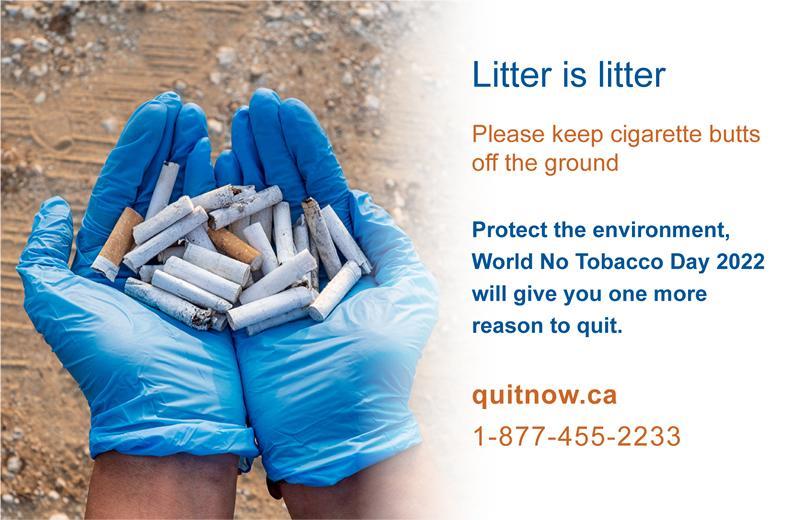World No Tobacco Day is May 31. This year, the goal is to raise awareness about the environmental impacts of commercial tobacco, e-cigarette and vapour products.
Commercial tobacco products are manufactured for recreational use, and harmful chemicals are added to make the products more tolerable and addictive. Some popular forms of commercial tobacco are cigars, cigarettes, smokeless tobacco, pipe tobacco, and hookahs.
When we think of trash and litter, do cigarette butts and vapour products come to mind?
Think of the K-cup hype, the hot new convenient coffee device everyone had to have. We are now in the same dilemma . . . where do we dispose of all these vapour products that have become so popular? Much like the K-cups, vapour products today are more practical and conveniently sized, but are no better than cigarette butts. Most of these devices do not include instructions on how to properly dispose of them and will end up in landfills or other areas where they can leak chemicals and battery acid.
Do discarded cigarette and vapour products harm the environment?
Cigarette filters may appear biodegradable, but they contain a plastic fiber called cellulose acetate, which can remain in the environment for as long as 10 years. As the filters slowly break down, the tiny pieces of plastic fiber, called microplastics, become dangerous to living creatures.
It may be hard to believe, but commercial tobacco waste is one of the most socially accepted forms of litter in the world. It is estimated that 4.5 trillion cigarette butts are littered yearly across the world. This waste may contain over 7,000 toxic chemicals, which are known to cause cancer, as well as leaking into and being stored in the environment.
E-waste from e-cigarette and vapour products includes leftover battery, metal, and plastic. With the recent change in technology for e-cigarettes, nicotine is easily and quickly consumed and just as rapidly disposed to contaminate our streets and ecosystems. Currently, the majority of e-cigarette and vapour products are not reusable or recyclable.
Do people who consume these products know how to properly dispose of them?
Most of the responsibility is put on the person who uses these products to figure out how to properly dispose of them. Currently, there is no standard way to recycle e-cigarette and vapour products.
The main question is, where and how do we dispose of this waste?
For the health and safety of the public and the environment, we need to develop ways to safely dispose of the waste created by vaping and the use of cigarettes. Such methods are already in place for other recyclable items such as glass, tetra packs, and aluminum cans.
Some Canadian recycling companies have started thinking upstream about recycling cigarette butts and old vapour products into plastic materials. Improper disposal of commercial tobacco, e-cigarette and vapour products does leave a negative impact on our environment for future generations.
Remember:
When it comes to understanding the importance of properly disposing of waste from cigarette and e-cigarettes, education is key. We should consider implementing more e-waste and cigarette disposal depots, restricting single use nicotine products, and stressing our duty to properly dispose of, reuse, and/or recycle our products. To stop or reduce the damage done by simply tossing our used products into the trash, or worse, the streets, we need systems that make it easier to recycle.
Support:
There are many good reasons to quit commercial tobacco or vapour products. If you or someone you know is interested in quitting or decreasing their use, encourage them to talk to their primary care provider (doctor or nurse practitioner). As well, they could check out the following resources:
- QuitNow offers free information, support, and counseling by trained professionals by phone, text, or email.
- The BC Smoking Cessation Program provides 12 weeks of free nicotine replacement therapy (gum, patch, inhaler and lozenges) per calendar year for each BC resident through their local pharmacy.
- Talk Tobacco offers culturally appropriate support to Indigenous people and communities for quitting smoking, vaping, and other commercial tobacco use.
Note: In this story, as in most public health messages, “tobacco use” refers to commercial tobacco products such as cigarettes and chewing tobacco, as opposed to traditional uses of tobacco.














Comments